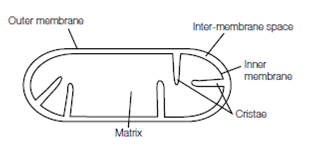Mitochondria
Mitochondria are double-membrane-bound organelles where the processes of respiration and oxidative phosphorylation occur. They are approximately 2–3 mm long and 1 mm in diameter. Their numbers in a cell vary. They contain a small, circular DNA molecule, which encodes some of the mitochondrial proteins, and 70S ribosomes. The inner membranes of the mitochondria contain an ATP/ ADP transporter that moves the ATP, which is synthesized in the organelle, outwards into the cytoplasm. ATP production is located on particles attached to the cristae, the inner infolded mitochondrial membrane. Their structures differ slightly between the protistan groups. Not all protista have mitochondria and in these cells metabolism is essentially anaerobic. In the aerobic, very primitive eukaryotes the mitochondrial cristae are discoid. Mitochondria of the fungi are large and highly lobed with flat, plate-like cristae, while those of the chlorophyta have much more inflated cristae.

Figure: Structure of a mitochondrion.